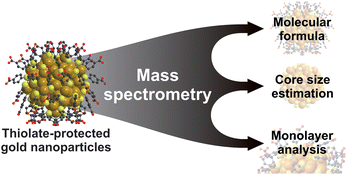Characterization of thiolate-protected gold nanoparticles by mass spectrometry
Abstract
Thiolate-protected

* Corresponding authors
a
Department of Chemistry, Vanderbilt University, 7330 Stevenson Center, Nashville, TN 37235, USA
E-mail:
john.a.mclean@vanderbilt.edu
Fax: +615 343-1234
Tel: +615 322-1195
b Vanderbilt Institute of Chemical Biology, 896 Preston Building, Nashville, TN 37232, USA
c Vanderbilt Institute for Integrative Biosystems Research and Education, 6809 Stevenson Center, VU Station B 351807, Nashville, TN 37235, USA
d Vanderbilt Institute of Nanoscale Science and Engineering, 6506 Stevenson Center, VU Station B 351806, Nashville, TN 37235, USA
Thiolate-protected

 Please wait while we load your content...
Something went wrong. Try again?
Please wait while we load your content...
Something went wrong. Try again?
K. M. Harkness, D. E. Cliffel and J. A. McLean, Analyst, 2010, 135, 868 DOI: 10.1039/B922291J
To request permission to reproduce material from this article, please go to the Copyright Clearance Center request page.
If you are an author contributing to an RSC publication, you do not need to request permission provided correct acknowledgement is given.
If you are the author of this article, you do not need to request permission to reproduce figures and diagrams provided correct acknowledgement is given. If you want to reproduce the whole article in a third-party publication (excluding your thesis/dissertation for which permission is not required) please go to the Copyright Clearance Center request page.
Read more about how to correctly acknowledge RSC content.
 Fetching data from CrossRef.
Fetching data from CrossRef.
This may take some time to load.
Loading related content
